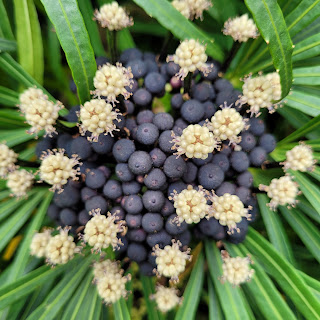Bulbuls in School (Updated)
Written by Mr William Teng
Bulbuls have been spotted in the school compound recently and specifically at the greenery in the roundabout in front of the school foyer.
A family of yellow-vented bulbuls are roosting in one of the palms there and quite a number of staff has seen them. Our vice-principal, Mr Derek Lee, has observed that they are particularly active in the evening.
Two teachers - Ms Minnoli and Mrs Franklin spotted a young yellow-vented bulbul fledgeling (a young bird that has grown feathers and is learning to fly) and took photos of it. We were warned not to approach it because its parents were aggressive and protective of it.
You can see that it still has its down feathers and appears rather fluffy. I managed to spot the young bird today and it is now able to fly.
Bulbuls are medium-sized short-necked passerine songbirds. Passerines are also known as 'perching birds' and can be distinguished from other orders of birds by the arrangement of their toes (three pointing forward and one back), which facilitates perching. [1]
Yellow-vented bulbuls are 'a species adapted to humans and may even nest in gardens'. [1] Here is a photo of an adult yellow-vented bulbul taken from a blog maintained by the Singapore Bird Group. (https://singaporebirdgroup.wordpress.com). The photographer, Johnson Chua, has described taking photos of bulbuls to be difficult.
[1] Wikipedia
Bulbuls have been spotted in the school compound recently and specifically at the greenery in the roundabout in front of the school foyer.
A family of yellow-vented bulbuls are roosting in one of the palms there and quite a number of staff has seen them. Our vice-principal, Mr Derek Lee, has observed that they are particularly active in the evening.
The palm where the birds are roosting
Photo: Mr William Teng
Two teachers - Ms Minnoli and Mrs Franklin spotted a young yellow-vented bulbul fledgeling (a young bird that has grown feathers and is learning to fly) and took photos of it. We were warned not to approach it because its parents were aggressive and protective of it.
Yellow-vented bulbul (Pycnonotus goiavier)
Photo: Ms Minnoli
Yellow-vented bulbul (Pycnonotus goiavier)
Photo: Mrs Franklin
You can see that it still has its down feathers and appears rather fluffy. I managed to spot the young bird today and it is now able to fly.
Yellow-vented bulbul (Pycnonotus goiavier)
Photo: Mr William Teng
Bulbuls are medium-sized short-necked passerine songbirds. Passerines are also known as 'perching birds' and can be distinguished from other orders of birds by the arrangement of their toes (three pointing forward and one back), which facilitates perching. [1]
Yellow-vented bulbuls are 'a species adapted to humans and may even nest in gardens'. [1] Here is a photo of an adult yellow-vented bulbul taken from a blog maintained by the Singapore Bird Group. (https://singaporebirdgroup.wordpress.com). The photographer, Johnson Chua, has described taking photos of bulbuls to be difficult.
Adult yellow-vented bulbul (Pycnonotus goiavier)
Photo: Johnson Chua
Interestingly, another bulbul species was spotted yesterday as I was returning to school from lunch. Perched on one of the branches of the shrubs of the roundabout was the red-whiskered bulbul (Pycnonotus jocosus). Like the yellow-vented bulbul, this bird can also be found in urban gardens. As I was about to take a photo of it, it flew away to a tree outside the school.
Here is a photo that was taken and posted by Mr Nick Baker on Ecology Asia.
Red-whiskered bulbul (Pycnonotus jocosus)
Photo: Mr Nick Baker
Different species of birds have been spotted occasionally in school including sunbirds and black-naped orioles but the appearance of two different species of bulbuls has been a rather fascinating coincidence. With the sprucing of our gardens and greenery, we hope to see and document more bird sightings.
Have you seen any birds in school lately? Please leave a comment below and share your photos with us.







Comments
Post a Comment